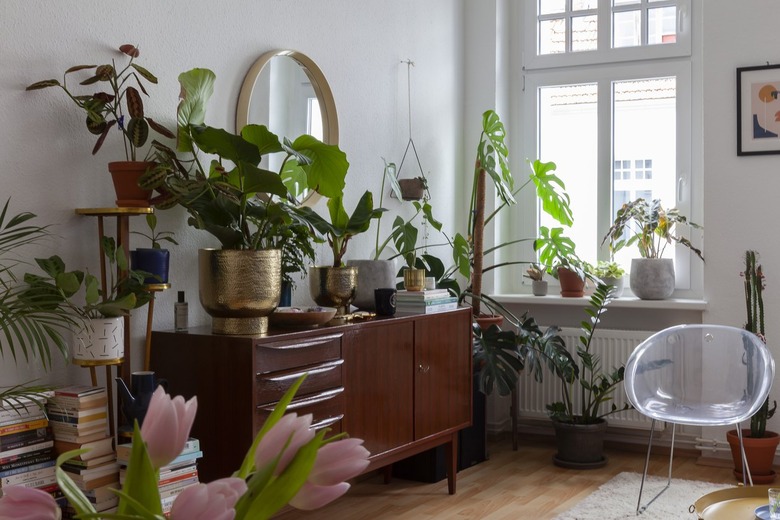When To Bring Plants Inside — And What Temperature Is Too Cold?
We may receive a commission on purchases made from links.
Even houseplants deserve a summer vacation, and many homeowners indulge their plants with a warm-weather visit to the patio or deck. But summer doesn't last forever, so keep those plants in mind as autumn comes around and the outdoor nighttime temperatures drop. At some point, your houseplants will need to come in before they suffer damage from the cold, and that point may be well above freezing.
Want to know when to bring your plants inside? Here's some advice on when to do it and how to ensure your houseplants stay healthy for the cool-weather season.
When to Bring Plants Inside
When to Bring Plants Inside
The ideal time for bringing most houseplants back indoors is when indoor and outdoor temperatures are about the same. This roughly happens in late summer rather than fall for most locations. If moved before or after this optimal outside temperature, the plants can suffer shock from the sharp differences between outdoor and indoor conditions.
Beyond waiting for the right temperature, knowing how to move plants correctly indoors is also important. If your houseplants have been in full sun, they should move inside to a south- or southwest-facing window or be placed under a grow light to receive that same light level. But unless you're moving your plants to a solarium, for example, that receives the same amount of full sun as they received outdoors, first move them from their spot in the sun to a partial shade location outside and then to a heavier shade location (also outdoors). If they have been in dappled light outside, try an east-facing window or a location that's near a west-facing window, but out of direct sunlight. Shade-loving plants may do best in front of north-facing windows or in a darker corner of a room.
Tip
To make sure all sides get sun exposure, experts recommend turning the pot one-quarter turn every time you water. Plants that need infrequent watering may start to lean toward the light between waterings. If this is the case, frequently turn them to ensure they receive light on all sides and to prevent them from leaing.
How Cold Is Too Cold for Plants?
How Cold Is Too Cold for Plants?
When it comes to houseplants, some like it hot (especially plants originating in the tropics, like Hibiscus rosa-sinensis), but almost all plants need it to be at least warm. So, what is the cutoff temperature for indoor plants spending the summer outdoors?
The critical temperature for which to watch is 45 degrees Fahrenheit. Most houseplants living outside for the summer need to be brought back indoors before overnight temperatures dip below 45 degrees. Some succulents may suffer harm even before this, so bring them inside when temperatures drop below 60 degrees. Another way to schedule the return of houseplants is to bring them in for winter at least two or three weeks before your average first frost date.
|
32 Degrees and Below |
There are a handful of hardy plants that can survive freezing and below-freezing temperatures. Though some, such as roses and peonies, may lose their leaves and flowers in very cold temperatures, the plant's roots will typically continue to survive. Many species of sempervivum, stonecrop, and sedum succulents can survive below-freezing temperatures, and some will even develop red, purple, or pink shades if left outside on cold nights. |
|
40 Degrees |
"Half-hardy" tropical plants can survive temperatures as low as 40 degrees. These include species such as peace lilies, ficus, and some orchids. Peace lily may be damaged at temperatures just 2 degrees below this 40-degree benchmark, however, and leaves may turn black when subjected to a temperature of 38 degrees. |
|
50 Degrees |
The majority of cacti, including Christmas cacti and bunny ears, prefer consistently cool climates around 50 degrees at night. For a Christmas cactus to set flower buds, don't bring it indoors too soon. These plants need cool nighttime temps between 50F and 55 F and short days to initiate flower bud formation. |
|
60 Degrees |
Most succulents and tender perennials prefer nighttime temperatures to remain above 60 degrees. These more delicate plants include jade, bear paws, string of pearls, tropical hibiscus, impatiens, and coleus. |
|
70 Degrees and Above |
Even the most tender plants should be OK at 70-degree temperatures, but too much or too little humidity as well as major temperature fluctuations can still be problematic. |
Check for Bugs Before You Move Indoors
Check for Bugs Before You Move Indoors
While you may be anxious to have your houseplants back in their traditional pots indoors, you don't want them to bring diseases or insect pests, like mealybugs, spider mites, whiteflies, aphids, or broad mites, into the house. Before moving your plants indoors, it's a good idea to check them for insects and do a proper debugging first.
To debug plants, start with a visual check of each leaf (especially the underside of leaves) and inspect the stems, pots, and saucers for evidence of infestations. Wipe away any webbing, bumps, or bugs using a cotton swab or clean cloth saturated with alcohol.
You may need to spray the foliage with insecticidal soap or neem oil. It's important to make sure the plant you're spraying with soap or oil isn't sensitive to these products; otherwise, it may be damaged. For example, dieffenbachia, dracaena, and many succulents may be damaged by the application of insecticidal soap, and hibiscus plants may be damaged by the application of neem oil. It's best to test any product on a small part of your plant first, and check the results after a few days to make sure that there's no damage.
Regardless of whether you have to treat any plants for pests, it's best to isolate them from other houseplants for several weeks just to make sure that they don't infest other plants.
Check for Cold Damage
Check for Cold Damage
If the entire plant seems to be wilting, it might be suffering from root rot. This is almost always caused by soilborne fungal pathogens that proliferate because of poor plant care, most commonly a combination of overwatering and poor drainage. Take the time to repot the plant in a clean container with ample drainage holes in the bottom of the pot (and if your plant has grown significantly, it may be a good idea to upgrade to a larger container). Use loose, well-draining potting mix instead of garden soil in your containers to make sure the water drains thoroughly. If you're growing succulents, use a potting mix that's specially blended for cacti and succulents. If sections of the roots look soggy, cut these off, wiping cutting blades with alcohol before making each cut to prevent the spread of possible disease.
Cold air and chilly winds can cause leaves to turn yellow, red, or purple, depeding on plant species. Prune the affected leaves with alcohol-sanitized pruning shears and immediately transfer the plant indoors. If there has been a freeze, you'll see even more damage. Frost damage turns leaves brown or black and can make them soggy, while stems can wilt, turn mushy, or collapse. They may look awful, but don't give up on them becoming healthy plants. Clip off damaged leaves and stems and site the plant indoors in indirect light. Keep the soil slightly moist and wait to see if new growth develops.
When to Move Plants Outside
When to Move Plants Outside
For most plants, it's best to wait until nighttime temperatures are consistently above 50 degrees. When it comes to heat-loving, fragile plants, you may want to wait even longer until it's consistently 60 or even 70 degrees outside at night. When in doubt, check the recommended cold-hardiness zone for the species in question. If it is limited to zones 10 and warmer, it is not adapted to freezing temperatures and will be very sensitive to cold weather. If there is a cold snap and you forget to bring the outdoor plants in immediately, they'll usually be OK and free from damage as long as frost doesn't hit the leaves, but the cold weather could slow their growth a little.
The minimum safe temperature for each plant species varies (as seen in our handy chart). A handful of particularly hardy plants may be able to go outside on a warm, sunny day when it is still snowy outside but be sure to bring them indoors after a short while and watch out for temperature drops. A thick layer of mulch or straw and some burlap wrapped around the container can help protect their roots from damage since pots do not insulate as well as outdoor soil.
Tip
Remember that plants adapted to cozy indoor temperatures typically need time to adapt to cooler outdoor weather and bright, direct sunlight. When you first take your houseplants outside, start by placing them in a shady spot early in the morning and gradually move them to brighter spots (never brighter than what is recommended for the specific plant species) for longer periods of time. The acclimation period should last for seven to 10 days.

